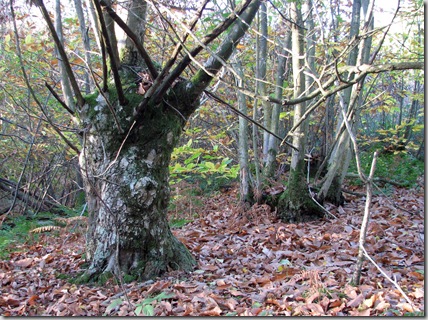Just to the north of the public footpath at TQ 8047 2022 there is a coppiced chestnut (Castanea sativa) with a high-cut stool whereas all the others in the area are low-cut almost to ground level. Both are shown in this picture:
George Peterken (1981) in his Woodland Conservation and Management cites many coppices in Britain where there is a haphazard and inexplicable mixture of low-cut and high-cut stools, though generally low-cut stools are reckoned to produce better poles.
He does say, however, that "some high-cut stools marked compartment boundaries in woods that were otherwise cut low." The example in the picture above is close enough to the footpath, which here follows the old track across the pond bay, for this to be a feasible explanation. It would be quite difficult, with a landmark like this, to lose the corner of the coupe (blocks of coppice are variously known as 'cants' or 'coupes' and by other local terms as well as 'compartments' and 'subcompartments'). The lower part of the high-cut stool (the trunk) is technically known as a 'bolling' (to rhyme with 'rolling').
